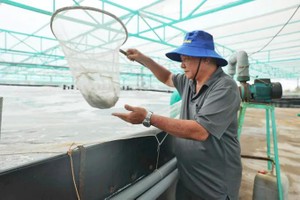 |
Illustrative photo |
However, banks that received credit from foreign financial institutions are few in number because of the high standards set for loan appraisal which all banks cannot meet.
The flow of foreign loans
At the end of November, the International Finance Corporation (IFC) completed disbursing loans worth US$150 mln to VPBank, equivalent to VND3,700 bln. In mid-November, VPBank also signed a syndicated loan agreement worth US$500 mln. Five major financial institutions participating in providing loans to VPBank include the Asian Development Bank (ADB), Sumitomo Mitsui Banking Corporation (SMBC), Japan International Cooperation Agency (JICA), NH ANZ, and Maybank Kim Eng Securities Pte. Ltd.
This year, several banks announced that they had obtained large loans from foreign financial groups. Specifically, VIB has just completed withdrawing a loan worth US$150 mln from IFC. In March, ADB and VIB announced a US$260 mln syndicated loan agreement. This is a three-year unsecured loan, including a direct loan of USD 100 mln from ADB and a syndicated loan of US$160 mln, co-arranged by ADB and UOB from nine leading Asian financial institutions.
In November, the US International Development Finance Corporation (DFC) also signed a loan of US$200 mln to SeABank for seven years. At the beginning of the year, SeABank was extended a credit package by IFC and five international investment funds from US$150 mln to US$220 mln after six months of cooperation. Recently, IFC has also proposed to invest a total of US$320 mln in three banks, namely, SHB, VIB, and OCB to support the loan portfolio for small and medium enterprises (SMEs). In June, Techcombank was also loaned by 26 international banks in a syndicate transaction worth US$1 bln.
Another form of foreign loan targeted by banks is the issuance of international bonds. In early 2022, LeapFrog Investments(IFC) and DEG of Germany, invested US$165 mln in tier-2 convertible bonds of HDBank. Currently, HDBank is consulting shareholders to issue US$500 mln of convertible bonds to international investors. This level 2 equity supplement convertible bond can be converted into common shares of the bank. The capital from the issuance will help the bank supplement medium- and long-term capital to serve growth plans according to to set strategy.
Recently, international capital flow into Vietnamese banks has also been more diverse in purpose. The traditional purpose of funding activities is for banks to expand their loan portfolios for SMEs, women-owned enterprises, and projects in the field of environment and climate change in Vietnam. However, a loan of US$150 mln from IFC has a term of five years with the purpose of supporting VIB to promote a loan portfolio for individual customers to buy, build, and repair houses to live in.
Prestige of banks
The mobilization of international capital at this time will reduce the pressure on domestic capital mobilization. Although international capital mobilization will face challenges in managing interest rate and exchange rate risks. However, some experts believe that the State Bank of Vietnam has enough regulatory tools for capital to be invested or reinvested.
This capital can help the bank balance the lack of medium- and long-term capital that has been outstanding for many years. In addition, the successful international capital calling from major financial institutions in the West not only helps banks have more internal resources and operational capabilities to expand the market but also reaffirms prestige and brand in the international market, thereby attracting back partners from other fastidious markets.
The Vietnamese economy is in dire need of capital. Compared with Foreign Direct Investment (FDI) capital, cash flow from indirect credit financing activities from foreign organizations reduces the approval process related to efficiency issues and environmental impact. Compared with non-credit institutions, the conditions for foreign loans from credit institutions are also better. For instance, credit institutions that want to borrow medium and long-term foreign loans must comply with the regulations of the State Bank of Vietnam on safety in banking operations. On the other hand, non-credit enterprises must meet more conditions for approval and regulations on loans.
Although it is more convenient than non-credit institutions in accessing international loans, banks that have received credit financing from foreign financial institutions in recent years have not changed much. They are still banks that have a history of being funded for many years before.
This shows that this capital flow is not accessible to all banks. Because in order to successfully mobilize syndicate loans in the international market or issue international bonds with great value, attractive interest rates, and maturity periods, banks must undergo a thorough evaluation by international organizations for the quality of operations, risk management, development potential, and segment strategy in accordance with set criteria.
Therefore, there have been many small-scale banks that have been looking for foreign strategic partners for a long time but have failed because they did not meet the criteria according to international practice. Similarly, the health of a bank as well as the customer segment of many banks currently do not match approval standards, leading to their exclusion from the list of major financial institutions.
























